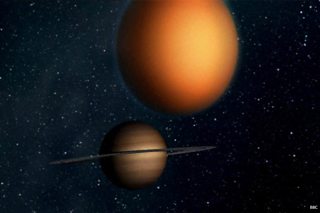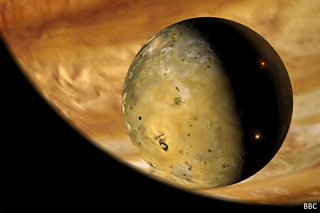
Titan and Saturn, imagined by �������� Two's 1999 series The Planets, which looked at the formation and evolution of the solar system
As Cassini-Huygens completes its final phase, we look back at the 20-year life of this space probe and see how the World Service’s Science in Action followed its journey, and how some other important space projects were reported by the ��������.
As Cassini-Huygens swoops through , the archive reminds us just how long the project has been running. The probe was launched in 1997, passing Venus and Jupiter more than six years later. In June 2004, Science in Action brought the to the World Service audience, as scientists exchanged high-fives.
reported when Cassini successfully despatched its spacecraft, the Huygens, to the “crème brulee” surface of the planet’s largest moon – Titan. The ��������'s Martin Redfern was at the European Space Operations Centre in Germany, and reported that "there was not a dry eye in the house". Cassini-Huygens later observed icy plumes rising from the moon Enceladus and sent back data showing liquid water beneath its frozen surface. The findings prompted talk among astrobiologists of the possibility of Titan supporting life.
Spacecraft like Cassini, often decades in the planning, and billions in the building, can take years to reach their destinations. They carry instruments to measure, photograph and analyse, as well as the hopes and theories of the scientists who created them. Their lives are so long, they are treated more like children than machines. Armchair astronauts can follow some of their trajectories through time and space, using to find episodes of Science in Action. So what does the programme tell us about other unmanned probes?

Image from the ��������'s The Planets - Brief Encounters, 2001
Ringing home
In September 1994, , the “fastest man-made vehicle in the universe”, which left in 1990 to explore unknown aspects of the sun. “When we go where no spacecraft has ever been before, even the best guesses can be wrong”, and scientists were surprised that Ulysses didn’t detect the sun’s expected magnetic pole when it flew by its rotational axis. Is it hidden by the solar wind of magnetic particles travelling at 800km per second, they asked.
Launched from the space shuttle Atlantis in 1989, Galileo reached the giant planet Jupiter after six years. In December 1995 it released a short-lived probe and Nasa finally released its findings, which were full of chemical surprises, including unexpectedly low levels of helium, which left scientists rethinking their views about the origins of the planet. Another stalwart of �������� space coverage, , promising that we were "in for some very exciting times". �������� Two's Sky at Night reported that on its travels, , and provided the "first definite proof that asteroids can have satellites".
In 1996, Mars Pathfinder mission was the first in 21 years to land a craft on the red planet. "They have every right to feel pleased with themselves," said . The report brought news of the rover Sojourner, which sent back photos showing that signs of massive amounts of water had passed over the planet in its distant history, and reported unexpectedly foggy mornings and blue clouds in a red sky.
If at first you don’t succeed
The Cluster Project was destroyed in 1996 when the Ariane 5 rocket carrying it went off course shortly after launch and had to be blown up. Its mission had been to study effects of solar winds on earth’s magnetic field. Andrew Coates, one of the scientists involved, of his feelings of "complete disbelief, and horror". All was not lost, however, plans were made to rebuild the 4 satellites of Cluster (“one of the “most ambitious space science projects ever attempted”). They were finally launched successfully in 2000, Cluster II had a long and successful career.
When it’s time to say goodbye
Farewell, Pioneer 10. Launched in 1972, it was the first spacecraft to go beyond the orbit of Mars and to get close to Jupiter. �������� Two's audience was treated to the sound of a radio signal from the probe during the , by Professor David Pye, as it headed out of the solar system. In . By then, its nuclear batteries were running down and bit by bit it was being turned off. Although project workers won a reprieve for its signature transmission, there would only be enough power left to keep transmitters bleeping for another year before it became a ghost ship coasting through interstellar space, probably for ever.
Science in Action has been a regular on the World Service for nearly 20 years and has more than 500 episodes available to listen to again. Now, there are more than 200 new iPlayer links on �������� Genome to episodes from 1994-1999.
